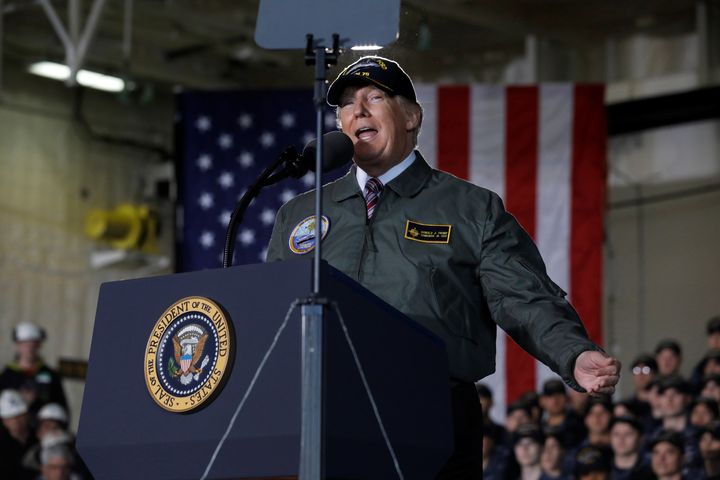Donald Trump has drawn sharp criticism from US veterans after making a speech aboard a new warship carrier whilst wearing a military coat and hat - despite his own questionable service record.
The President appeared to relish sporting a green naval bomber jacket and baseball cap when he spoke in Virginia on Thursday and made clear his delight: “You know what, they just gave me this beautiful jacket. They said, ‘Here Mr President, please take this home.’
“I said, ‘Let me wear it,’ and then they gave me the beautiful hat and I said, ‘You know, maybe I’ll do that’. We have a great ‘Make America great again’ hat but I said, ‘This is a special day, we’re wearing this, right?’”

Trump received five draft deferments during the Vietnam War - four for college and one for “bone spurs” in his heels.
Before this the athletically-built, six foot two-tall, 22-year-old played American football, tennis, squash and was just about to fall in love with golf.
A number of people claiming to be veterans of the US armed forces made their displeasure known.
Trump was also criticised earlier in the day for a section in his speech to Congress on Tuesday in which he paid tribute to Ryan Owens, the Navy SEAL killed in a botched Yemen raid in January.
His father, Bill, is also demanding an investigation into the hastily planned operation that also resulted in the deaths of at least 25 Yemenis, including 10 children and nine women.
He told The Miami Herald: “I want an investigation. The government owes my son an investigation.”
Trump’s Virginia speech hyesterday came from the Gerald R. Ford, a $12.9 billion aircraft carrier being built in Newport News, reports the Associated Press.
He made a number of statements whilst reiterating his pledge to hike defence spending.
TRUMP: “We are going to have very soon the finest equipment in the world.”
THE FACTS: Pentagon leaders have said for years that the U.S. already has the world’s best weaponry and military equipment. They sometimes claim the U.S. is in danger of losing its advantage unless the Congress continues to spend heavily to develop and build new generations of weapons.
The Navy’s top officer, Adm. John Richardson, has said repeatedly that the Navy is the world’s finest. He also has said the Navy must adapt to a world of changing security threats. Richardson’s main focus has been on sharpening and changing the way sailors think about the nature of war, rather than relying on bigger budgets.
“We will not be able to ‘buy’ our way out of the challenges that we face,” he wrote in a January 2016 plan for maintaining U.S. naval superiority.
TRUMP: “This great aircraft carrier provides essential capabilities to keep us safe from terrorism and take the fight to the enemy for many years in the future.”
THE FACTS: Aircraft carriers are not the crucial element in the defense against terrorism. They do provide a flexible means of bringing warplanes and intelligence-gathering aircraft to areas where terrorists are being hunted, like off the coast of Libya or in the Persian Gulf, but their main function is to deter bigger wars with state powers like China, Russia and North Korea. The Pentagon’s counterterrorism campaigns rely more on special operations forces, Air Force fighters and surveillance drones, military trainers and advisers and the intelligence agencies.
TRUMP: “I am calling for one of the largest defense spending increases in history.”
THE FACTS: Three times in recent years, Congress raised military spending by larger amounts, in percentage terms, than the $54 billion, or 10 percent, increase that Trump proposes. The base defense budget grew by $41 billion, or 14.3 percent, in 2002; by $37 billion, or 11.3 percent, in 2003, and by $47 billion, or 10.9 percent, in 2008, according to Defense Department figures.
The proposed expansion pales in comparison with skyrocketing increases in earlier times. Military spending consumed 43 percent of the economy in 1944, during World War II, and 15 percent in 1952, during the Korean War. It was 3.3 percent in 2015, says the World Bank.
TRUMP: “Our Navy is now the smallest it’s been since, believe or not, World War I. Don’t worry. It’s going to soon be the largest it’s been.”
THE FACTS: No, the fleet is not growing to the largest it’s been, or anything close.
The fleet indeed shrank to its smallest size since the decade after World War I - bottoming out at 271 in 2015 before rising to 274 this year, compared with 139 in 1930. But that number alone is not that meaningful.
The nature of warfare has changed since the naval battles of the world wars - the rise of air power being just one significant factor. As well, for the last few decades the Navy has dramatically increased the warfighting effectiveness of its ships, meaning it can do more with far fewer vessels than it could during the Cold War, for example.
The fleet stood at a record high of 6,768 fighting ships during World War II, declined gradually in the 1950s and ‘60s and shrank significantly after the Vietnam War. During the 1990s the number fell from the high 500s to the mid-300s as the Navy decommissioned many older ships and the U.S. reaped a “peace dividend” from the end of the Cold War. The count includes aircraft carriers, cruisers, destroyers, submarines, amphibious assault ships and other large combat ships.
The fleet may grow more than planned if Trump’s military expansion is approved by Congress. But no one is talking about matching - much less exceeding - the enormous armada of another age.
The number of Navy personnel has also fallen over time, from more than 725,000 in 1954 to about 323,000 now. It’s unlikely to grow anywhere near that higher level.